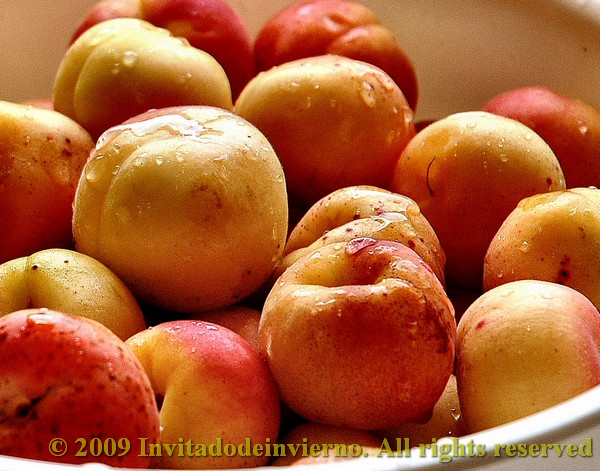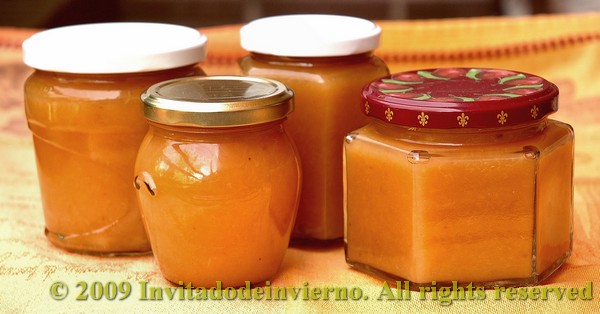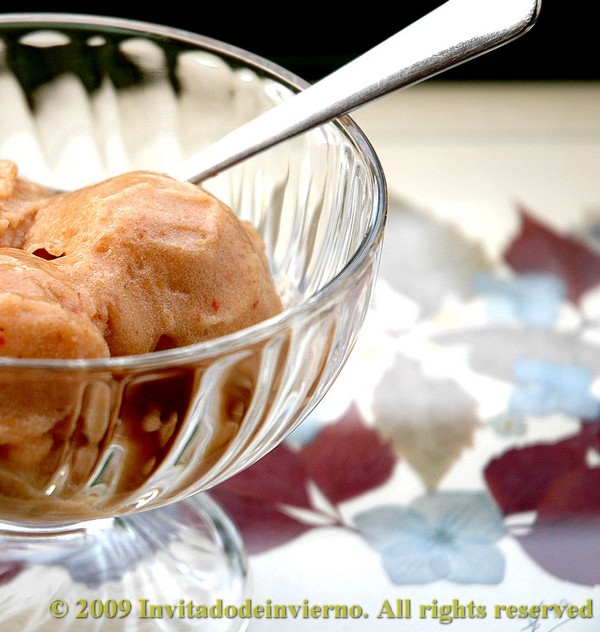Apricots galore
>> Tuesday, July 7, 2009

What to do if life gives you 10 kilos of juicy organic apricots? Organic means that the only additive they carry is some bird's poop or some insect track... in short, they are lucky if anyone has given them a look or if they have been watered at all during Spring. Wild nature in full! The apricot-tree was old enough to get by on his own.
Therefore I had to ponder on what to do with all these apricots, a gentle gift from my sister. It couldn't be 10 tarts. I was compelled to process the apricots quickly, to prevent them from ruining in a kitchen at 28 ºC... my skin looks so good after getting rid of all those toxins by sweating. I should be grateful after all. Being that I'm not very imaginative I made:
Jam...
Apricot sorbet...
Apricot curd...
And the remaining apricots were locked up in the freezer, nicely cut in half and pitted.
Jam (shoddy recipe)
Fill an enameled pan with as much halved and pitted apricots as you can fit. Add sugar or fructose in my case, at a guess. No scientific method here. Bring the mixture to a boil while stirring every now and then. I needed more than one hour, but the jam takes longer to thicken when you use fructose instead of sugar. Check the consistency and sweetness after half an hour and adjust the sugar/fructose if necessary. If the mixture is too fluid, then it needs to be concentrated further. Once attained the desired consistency, pour in reused glass jars, the kind you always keep and never get rid of. I have hundreds. These jars must be previously sterilized in boiling water for half an hour, well covered in water, and left to drain upside down on a clean towel. Then you pour the jam in the jars almost to the brim. You can use a large spoon too. Cover tightly with the lid and leave them to cool in an upside down position. By the way, you can process the fruit pieces or not. I processed it in the end because I found the apricot pieces were too large and recognizable.
Apricot sorbet (formal recipe, adapted from Not without salt)
Add the sugar or fructose to the water and bring to a boil, until all is dissolved. Put off the heat and add the basil leaves, leave to infuse. Let it cool to ambient. Add the liqueur to make up one cup. Put it in the fridge to cool thoroughly before use.
You must already have your apricots halved, pitted and frozen. Put them in the processor bowl with the syrup cup and process the whole until soft. You can serve it immediately (it makes a soft sorbet) or leave it in the freezer to harden further.
Apricot curd (a somewhat shoddy recipe)
Adapted from this recipe:
Halve and pit the apricots, put them in a pot. I use the Thermomix for that, because it let's you adjust the temperature. Otherwise you'll need a double boiler or a heatproof bowl inside a pan. Process the apricots and cook them only enough for them to soften a bit. Then process them to a very fine puree. The skins must be hardly noticeable, otherwise you'll have to strain the mixture and get rid of the coarser skins and bits. Add the butter to melt and cook at 80 ºC in the Thermomix or with a bain marie. Be careful not to overheat or it will separate. The amounts are a bit excessive for the traditional method, I would scale them down (remember I had a whole cargo of fruit to get rid of). Add the sugar and eggs and heat up the mixture stirring every now and them, till it thickens (speed 1 1/2 for Thermomix). It takes around 20-25 minutes to thicken, depending on the final amount of ingredients you use and on the eggs size. Check the consistency on the back of the spoon, if the custard covers it, it's done. Once the curd is done, fill sterilized jars to the brim. This is important because the curd shrinks on cooling. Cut a greased paper circle the size of the jar opening and lay it carefully on the curd. The curd forms a skin as any other custard. Cover with the lids, adjust them tightly and let cool to ambient. The curd keeps for three months in the fridge and six months in the pantry. But I don't think it will last that long once you try it... it's delicious! Mine was a bit too liquid, as you see in the picture. Maybe I should have cooked it at a higher temperature, but I didn't dare. Maybe the amount of fruit was too much. I will improve it next time.
And that's how I used all my beautiful apricots, not a single bit unused! Recession is leading us to a higher level of wisdom!
















8 comentarios:
Miriam! Beautiful!! Check out my blog, I just nominated you for a Kreativ Award :)
Besos!
Diana
Thanks a lot, Diana!
Your sorbet is an ideal refreshing recipe for hot summer days. Thank you!
Greek Food: give it a try... It's healthy, light and refreshing! Thanks for visiting!
Miriam, your apricots are little beauties!
I liked the sorbet and will try to make it one of these days. The apricots-and-basil combination sounds good.
Hi Nadejda! Welcome to my site! And yes, the basil scent is a nice addition to the sorbet.
I wish I received that bounty of apricots, I'm jealous! These look delicious...I particularly am fond of your jam. Yum.
Tasty: thank you, I have some jam everyday for breakfast, yes!
Post a Comment